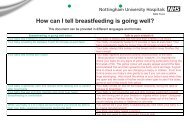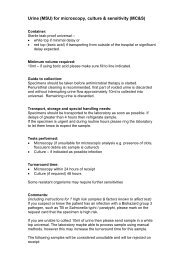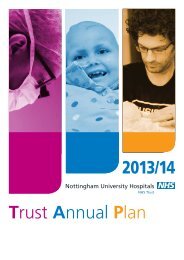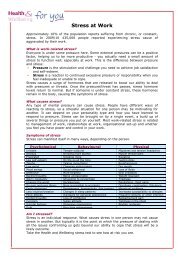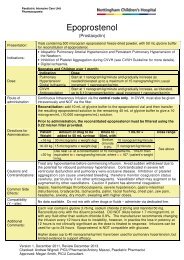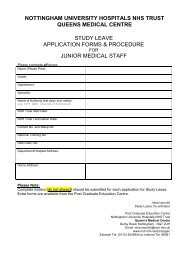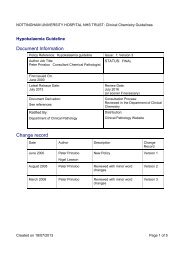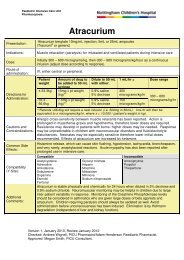Please click here to see the guidance - Nottingham University ...
Please click here to see the guidance - Nottingham University ...
Please click here to see the guidance - Nottingham University ...
Create successful ePaper yourself
Turn your PDF publications into a flip-book with our unique Google optimized e-Paper software.
Dear ColleagueTHE CONTROL OF MEDICAL EXPOSURESi.e. <strong>the</strong> exposure of patients and volunteer subjects <strong>to</strong> X-rays and radioactive substances(collectively known as “ionising radiations”)Information for General PracticesThe process of medical exposure, which includes <strong>the</strong> requesting of X-rays, is subject <strong>to</strong>statu<strong>to</strong>ry control.As an employer offering a radiology service, <strong>Nottingham</strong> <strong>University</strong> Hospitals NHS Trust hasa statu<strong>to</strong>ry duty <strong>to</strong> provide <strong>guidance</strong> on <strong>the</strong> making of referrals, <strong>to</strong> those entitled <strong>to</strong> make<strong>the</strong>m.This information is sent <strong>to</strong> you as part of that duty.Overleaf you will find–information on <strong>the</strong> regula<strong>to</strong>ry framework which controls <strong>the</strong> process of medical exposure;<strong>guidance</strong> on your responsibilities as a Referrer;information on w<strong>here</strong> detailed referral guidelines for specific examinations may be found;details of issues <strong>to</strong> which <strong>the</strong> Trust specifically wishes <strong>to</strong> draw your attention.The Trust presently uses <strong>the</strong> <strong>guidance</strong> issued by <strong>the</strong> Royal College of Radiology, for <strong>the</strong>majority of examinations. This is available on <strong>the</strong> internet at http://www.irefer.org.uk/Referral guidelines for examinations not covered by <strong>the</strong> RCR <strong>guidance</strong>, or for whichdifferent <strong>guidance</strong> is more appropriate for local circumstances, may be made available <strong>to</strong>you from time-<strong>to</strong>-time.Dr S.C WhitakerConsultant Radiologist<strong>Nottingham</strong> <strong>University</strong> Hospitals NHS Trust
IntroductionThe amount of radiation <strong>to</strong> which <strong>the</strong> population is exposed as a result of medical exposures continues <strong>to</strong>increase and yet as many as 30% of diagnostic examinations involving ionising radiation are unnecessary ordo not result in commensurate benefit for <strong>the</strong> patient.The main hazards from diagnostic examinations are <strong>the</strong> later development of cancer and genetic damage. Therisk of inducing a fatal cancer is small but relevant and is related <strong>to</strong> <strong>the</strong> dose and <strong>the</strong> patient’s age. Forinstance <strong>the</strong> additional lifetime risk of inducing a fatal cancer with a barium enema is approximately 1 in 3000.Genetic damage has not been observed in humans and <strong>the</strong> risk, which is quoted as not more than 10% of <strong>the</strong>cancer risk, has been estimated from various animal experiments. The foetus and children are at substantiallyhigher risk from ionising radiation because of rapid cell growth and longer life expectancy. For a given radiationdose <strong>the</strong> risk of inducing a malignancy is 3 times greater for a 1 year old than that for <strong>the</strong> general population.In order <strong>to</strong> minimise <strong>the</strong> risks from unnecessary and inappropriate examinations medical exposures aresubject <strong>to</strong> statu<strong>to</strong>ry controls (<strong>the</strong> “Ionising Radiation (Medical Exposure) Regulations 2000”, or IR(ME)R – <strong>see</strong>overleaf) which impose a duty <strong>to</strong> justify individually every exposure, <strong>to</strong> ensure that t<strong>here</strong> is benefit <strong>to</strong> <strong>the</strong>patient which outweighs <strong>the</strong> risk.Minimisation of exposureT<strong>here</strong> are some important steps that you, as <strong>the</strong> referrer, can take <strong>to</strong> minimise radiation exposure for yourpatients.Is <strong>the</strong> examination really necessary?Will <strong>the</strong> examination really answer your clinical question? For instance, a plain film of <strong>the</strong> abdomen inacute renal colic will nei<strong>the</strong>r confirm nor exclude <strong>the</strong> diagnosis of renal colic and will not excludeconditions that mimic renal colic.Will <strong>the</strong> results alter your management of <strong>the</strong> patient?For instance radiographs of <strong>the</strong> coccyx after injury do not contribute <strong>to</strong> management because treatmentwill be <strong>the</strong> same whe<strong>the</strong>r or not t<strong>here</strong> is evidence of coccygeal injury on <strong>the</strong> X-ray.Some o<strong>the</strong>r examples of examinations that are often hard <strong>to</strong> justify are:Skull radiographs in headache, neurological problems, suspected pituitary problems and past trauma.Lumbar spine radiographs in patients aged 20 <strong>to</strong> 55 years with chronic, stable symp<strong>to</strong>ms of back pain.To help with this judgement <strong>the</strong> Royal College of Radiology (RCR) has published a set of clinicalguidelines which is available <strong>to</strong> you on <strong>the</strong> internet at http://www.irefer.org.uk/. T<strong>here</strong> are many o<strong>the</strong>rinstances w<strong>here</strong> plain film radiographs provide little information of value, which are listed in <strong>the</strong> RCRGuidelines. Justification of individual requests will be based on <strong>the</strong>se guidelines.Avoidance of repetition - Has <strong>the</strong> examination been done already?Provide relevant clinical informationAccurate clinical information helps <strong>to</strong> ensure that <strong>the</strong> correct examinations, or views, are performed inorder <strong>to</strong> answer <strong>the</strong> clinical question. Provision of clinical information is necessary <strong>to</strong> justify <strong>the</strong>examination and is, t<strong>here</strong>fore, a legal requirement.Use, or refer for, a radiation free alternative when possibleE.g. ultrasound. The RCR guidelines include suggestions for appropriate imaging in many commonclinical scenarios.
An introduction <strong>to</strong> IR(ME)R 2000 for all those who make X-ray or NuclearMedicine requests (i.e. Referrers) and an explanation of <strong>the</strong>irresponsibilities.The medical exposure of human subjects (which includes exposure for research, screening programmes andmedico-legal purposes) is controlled by <strong>the</strong> Ionising Radiation (Medical Exposure) Regulations introduced in2000 and commonly referred <strong>to</strong> as IR(ME)R.The purpose of this legislation is <strong>to</strong> protect patients and volunteers from unnecessary or inappropriateexposure, or exposure by equipment which is unsuited <strong>to</strong> <strong>the</strong> task. The Regulations <strong>see</strong>k <strong>to</strong> achieve this byrequiring that individuals involved in <strong>the</strong> process of medical exposure, from referral through <strong>to</strong> reporting, have<strong>the</strong> training needed <strong>to</strong> properly carry out <strong>the</strong>ir duties and have received formal authorisation <strong>to</strong> undertake thoseduties from <strong>the</strong> Trust. The Regulations also make <strong>the</strong> Trust responsible for ensuring that t<strong>here</strong> is a frameworkof procedures in place <strong>to</strong> address patient protection issues. The negligent or malicious failure <strong>to</strong> comply with<strong>the</strong>se requirements is a criminal offence.The process for medical exposureRequest(by a ‘Referrer’)Justification(by a ‘Practitioner’)and authorisation(by a ‘Practitioner/Opera<strong>to</strong>r’)Medical exposure(by an ‘Opera<strong>to</strong>r’)Recorded clinical evaluation(by a ‘Practitioner’ or ‘Opera<strong>to</strong>r’)Framework of employer’s supporting proceduresThe regulations define <strong>the</strong> following duty holders, who must be identified in Trust procedures as being entitled<strong>to</strong> carry out <strong>the</strong>ir specific tasks–‘Referrers’ – healthcare professionals who may make requests for X-ray or Nuclear Medicine examinations(usually hospital clinicians and GPs but also specially trained nurses or o<strong>the</strong>r professionals whom <strong>the</strong> Trustpermits in its written procedures). See over for more information.‘Practitioners’ – healthcare professionals whose responsibility it is <strong>to</strong> justify that a particular radiologicalexamination be undertaken for a given request, on <strong>the</strong> basis of <strong>the</strong> available clinical information. They musthave specialist training as laid down in <strong>the</strong> IR(ME)R (usually Radiologists but may be Cardiologists, Dentists oro<strong>the</strong>rs whom <strong>the</strong> Trust permits in its written procedures).‘Opera<strong>to</strong>rs’ – persons who carry out practical tasks related <strong>to</strong> <strong>the</strong> process of medical exposure. They musthave specialist training as laid down in <strong>the</strong> IR(ME)R (e.g. radiographers, interventional radiologists,cardiologists, clinicians reporting X-rays).…
ReferrersEntitlement <strong>to</strong> make requests for X-ray and Nuclear Medicine investigationsThe Trust (QMC, <strong>University</strong> Hospital NHS Trust) entitles <strong>the</strong> following <strong>to</strong> act as Referrers:registered medical and dental practitioners;non-medical healthcare professionals who are state registered and have INDIVIDUAL WRITTENpermission according <strong>to</strong> procedures established by <strong>the</strong> Trust Radiation Safety Group.Within this definition, individual Trust direc<strong>to</strong>rates or departments may place limitations on who may refer <strong>to</strong><strong>the</strong>m for <strong>the</strong>ir radiological services, or limitations on <strong>the</strong> scope of referrals (e.g. <strong>the</strong> types of examination forwhich a particular group may refer).Referral guidelinesReferral guidelines list <strong>the</strong> generally accepted indications for undertaking a particular radiological examination.They also indicate w<strong>here</strong> certain investigations have been proven NOT <strong>to</strong> assist patient management.Radiology service providers are obliged <strong>to</strong> make referral guidelines available <strong>to</strong> referrers. For general X-rayrequests <strong>the</strong> Diagnostic Imaging Direc<strong>to</strong>rate uses <strong>the</strong> Royal College of Radiology guidelines with somemodifications for local practice. These guidelines are available on <strong>the</strong> internet at http://www.irefer.org.uk.Requests which fall outside <strong>the</strong> guidelines may still be justified but will need additional clinical data <strong>to</strong> do so, ordiscussion directly with a Practitioner (radiologist).All requests received for medical exposure will be considered for <strong>the</strong>ir appropriateness. Inappropriate requestswill be rejected.Referrer DutiesIf you make a request for an X-ray or Nuclear Medicine investigation, you must:provide sufficient clinical information on <strong>the</strong> request <strong>to</strong> support its justification;provide sufficient information <strong>to</strong> identify unambiguously <strong>the</strong> patient or volunteer;provide <strong>the</strong> information in a legible format; andidentify yourself and sign <strong>the</strong> request (in <strong>the</strong> case of handwritten requests).All medical exposures must be individually justified by a Practitioner. If <strong>the</strong> clinical information you providedoes not justify <strong>the</strong> proposed examination <strong>the</strong>n <strong>the</strong> request will be refused.<strong>Please</strong> note that when you sign an X-ray request you take <strong>the</strong> legal responsibility for <strong>the</strong> information which itcontains. If you can not do this, do not sign it. In particular, requests MUST NOT be “pp’ed”, you MUST NOT presignrequest cards (“blank cheques”) and you should not make requests for serial examinations of <strong>the</strong> sametype in advance (e.g. a week’s daily post-operative chest x-rays) because <strong>the</strong> clinical setting may change after<strong>the</strong> request is sent. If you are making a request <strong>to</strong> check <strong>the</strong> result of some clinical procedure (e.g. NG tubeplacement), please only do so after you have completed <strong>the</strong> procedure.Similarly, electronic requests should ONLY be entered on <strong>the</strong> referrers own password. You should never entera request on someone else’s password (even if you are authorised <strong>to</strong> make such a request). You should neverallow anyone else <strong>to</strong> make referrals under your own password, even if <strong>the</strong>y are an authorised referrer.Remember that YOU are legally responsible for any electronic request made on your password.Mobile radiography requestsMobile X-Ray units may produce images of poorer quality than standard equipment in main X-Ray and exposeo<strong>the</strong>r people on <strong>the</strong> ward <strong>to</strong> X-Rays. For <strong>the</strong>se reasons, mobile radiography (e.g. chest X-Rays on <strong>the</strong> ward)must only be used when t<strong>here</strong> is a valid clinical reason (for instance, <strong>the</strong> patient is <strong>to</strong>o sick <strong>to</strong> leave <strong>the</strong> ward).Non-availability of staff <strong>to</strong> escort patients <strong>to</strong> main X-Ray is not a valid reason.Screening for pathologyScreening procedures for pathology in asymp<strong>to</strong>matic individuals that use ionising radiation are only justified ifa national authority has determined that <strong>the</strong> radiation exposure during screening is low, <strong>the</strong> disease issufficiently common and t<strong>here</strong> is effective treatment available which is benefited by early detection. Anexample of such a screening program would be mammography in patients after <strong>the</strong> age of 50.
Examinations for legal and insurance purposesExaminations specifically for legal and insurance purposes should be limited or excluded. Carefulconsideration is required <strong>to</strong> ensure that such requests really are in <strong>the</strong> direct interest of <strong>the</strong> person concernedand in many cases this is not <strong>the</strong> case.ReferencesiRefer – http://www.irefer.org.uk - Published by <strong>the</strong> Royal College of Radiology.“Radiation and your patient: A guide for medical practitioners”. Published by <strong>the</strong> International Commission onRadiological Protection (www.icrp.org).



